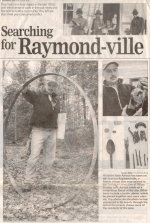Searching for Raymond-Ville
Saturday, May 19, 2001
-
by Kevin Adshade
The Evening News
|

(Click on image to see larger picture) |
Photo caption:
Historian John Ashton has been on the hunt for Raymond-ville,
a French village that once existed in the Trafalgar-Lorne area of
Pictou County.
Left: Ashton holds up a metal loop found at
the site. Other items include a bottle, above, which he pieced
together and some utensils.
Top photo: An old photo he has
uncovered in his search through historical documents shows some of the
residents of the area. |
A long-forgotten French settlement that existed in the Trafalgar-Lorne
area is coming back to life, thanks to the work of a local amateur
historian.
Bridgeville’s John Ashton began researching Raymond-ville about
three years ago.
Following Confederation, French settlers were enticed to Canada by a
government intent on “building the country,” Ashton said.
“I figure it was around 1877. I’m pretty sure it dates about
then. They only stayed until about 1880. There were only
two families left there after 1881 – the Bonetts and the Oudins.
Not many people now know about the settlement.”
Families such as Gougie, Guy, Vacheresse, Bonnet, Hommé and Alphonse,
made the trans-Atlantic trek from their homelands of France and
Luxembourg.
They were promised free land, free passage and were guaranteed jobs at
Pictou County coal mines when they arrived.
“That was the main reason they came here (but) they found out Canada
was still building.”
When
the U.S. slapped a tariff on Canadian coal in 1870s, the jobs dried
up, inciting riots and strikes by the miners.
Many
of the French settlers either went back to France or headed to Quebec.
Others went south to the U.S. coal belt, places such as West Virgina
and Pennsylvania according to Ashton.
After
Ashton began his research on Raymond-ville, he stumbled upon an old
well, which sat near the remains of a log cabin about 25 to 30 feet in
dimension. He subsequently discovered that the cabin had been
occupied by a Passruix family, who lived there for about two years
before moving on.
“He
and his brother had a plot of land beside each other. Where they
went, I don’t know.”
He
added there was supposed to be 11 log cabins in the area.
“I’ve found five of the old log cabin foundations.”
Ashton
said the settlement is slowly being worn away by the passing of time,
as remnants decay and forest growth begins to dominate the area.
He
said there is a cemetery still in existence.
“There’s
supposed to be six individuals buried there. There’s only one
tombstone there and that’s to the Bonnet’s. There’s a
fence around it and there’s a gentlemen there who looks after it
now.”
Through
his interest in Raymond-ville, Ashton has collected a ladle, spoon,
forks, nails, bottles, pottery, and old iron skillet, a horse-shoe and
an axe head.
“When
you’re going through an old site and you even just find a nail,
(anything) showing there were people here, trying to build a community
- you’re excited when you find something like that.”
Ashton,
who was guest speaker recently at a monthly meeting of the Pictou
County Roots Society, where he gave a presentation of the research he
has conducted thus far on the settlement, keeps in contact with some
descendants of the Raymond-ville inhabitants.
One
of these descendents is Fay Hommé Ziegler of Souderton, Pennsylvania.
Her great-grandfather settled in Raymond-ville and lived in the area
for about two years before moving to Pennsylvania. Hommé
Ziegler has plans to travel to the area later this year.
“She
has relatives here in Pictou County,” Ashton said. “She’s
coming up to see the area where her relatives lived.”
Ashton
also plans to bring more attention to Raymond-ville in three years
time, when the 2004 Acadian World Congress – a celebration of the
French culture – is held.
Ashton
says introducing Raymond-ville to the Acadian world at large, is a way
for Pictou County to contribute to the Acadia Congress.